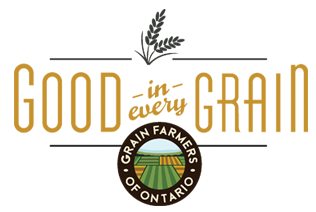From Field to Table: Soybeans

April is National Soy Foods Month, and the perfect time to highlight this Ontario grain! Ontario is the largest producer of soybeans in Canada. In 2024, 4.4 million tonnes were harvested in the province on just over three million acres. Soybeans can be used for a variety of edible and non-edible products that you can find in your homes, grocery stores, hardware stores, or around the world! Over 50 per cent of the soybeans grown in Ontario are exported to international markets to be made into consumer products, including tofu, tempeh, and soy beverages.
Many people enjoy soy-based foods without realizing the journey soybeans take from the farm to their plate.

Soybean Life
Soybeans are planted in the spring months and will grow into green leafy plants through the summer. During this time #YourFarmers will make sure the crop is growing healthy: that the fields have enough available nutrients to successfully grow, and that pests (weeds, diseases or insects) aren’t harming the crop. Through the summer months, the soybean plants will grow and develop pods- inside the pods are the soybean seeds.
Once mature, in the fall soybeans will actually change colour (much like trees!) from a green to a brown colour. In the fall, soybeans will also drop their leaves, leaving only the pods on the plants, and fully developed soybean seeds.
Harvesting on a grain farm is the process of removing the seeds from the mature plant. A combine (harvester) will drive along the rows of a grain crop in the field, cut down the plant and then separate the seeds from the rest of the plant.
Once the seeds are removed from the combine, they will be put onto a truck or wagon and be hauled to a storage facility- a grain elevator. Here they will be stored, dried (if the seeds are too for proper storage), and be held until the soybean seeds can be moved to processing.
Processing
Once soybeans are harvested, they undergo processing to be used in a variety of things including food products, animal feed and even industrial applications. The two main processing methods are crushing for oil and meal production and whole soybean processing for food-grade uses.
Crushing for soybean oil and meal: Most soybeans grown worldwide are processed through a crushing method that separates the oil from the meal (rest of soybean material). This process is primarily used for producing cooking oil, industrial products, and high-protein animal feed. After the oil is extracted, the remaining flakes are toasted and ground into soybean meal, which is high in protein and widely used in livestock and poultry feed. Some soybean meal is further processed into soy protein concentrates and isolates, which are used in protein bars, meat alternatives, and nutritional supplements.

Whole soybean processing for food-grade uses: Unlike soybeans crushed for oil and meal, some soybeans are processed as whole seeds to create food-grade soy products commonly consumed by people worldwide. Things like soy beverages, tofu (made from soy beverage), tempeh, miso and soy sauce, and even roasted soy nuts! All of these food products are processed from whole soybeans and turned into food products that can be used in a variety of different meals.
- Soy beverage → Dairy alternative for drinking, coffee, and cooking.
- Tofu & Tempeh → High-protein plant-based foods used in stir-fries, soups, and sandwiches.
- Miso & Soy Sauce → Flavorful condiments used in Asian cuisine.
- Soy Nuts → Nutritious snack packed with protein and fiber.
Ontario soybeans play a vital role in feeding both humans and animals worldwide, and the versatility of soy-based foods can be found in everyday life. Check out some of our favourite soy recipes to try this month.



